America is about to be invaded by ninjas.
Not the black-clad assassins of Japanese lore, of course, but obstacle courses modeled on the wildly successful TV series American Ninja Warrior, now in its 10th season and currently drawing in excess of 75,000 contestants across the U.S. The show, which pits amateur athletes against a challenging course that rewards both agility and strength, draws more than 5 million viewers nightly, many of whom are eager to test their own skills as well as get their kids climbing, leaping, and swinging through similar courses near home and while on vacation.
Ninja courses are beginning to pop up in a host of different types of facilities and properties from coast to coast. They are a standalone activity at some, and are an additional activity at others, such as family entertainment centers, trampoline parks, and, of course, aerial adventure parks.
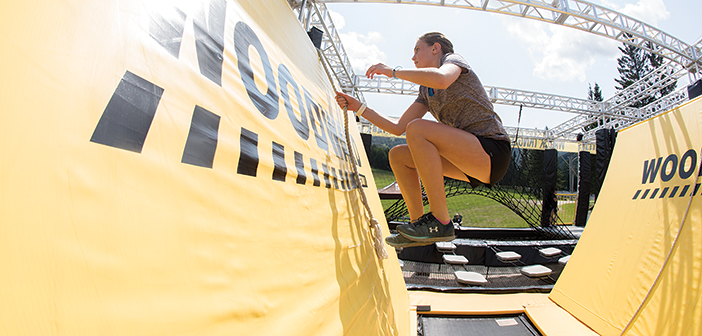
A new-age ninja scales the wall at Killington’s Wrecktangle.
These courses have cachet, thanks to the show. They can be big or small, indoor or outdoor, very difficult or manageable for all ages—or all of the above. And they can be a complementary activity to zip lines and aerial courses.
Fun and Function
The standard American Ninja Warrior course starts with quintuple floating steps, followed by four varied obstacles and ending with a warped wall that contestants must scramble up to hit a buzzer and register their course time. When it comes to designing commercial ninja courses (also called “warrior courses”), however, what works on TV isn’t always the model for parks faced with the reality of crowd control and keeping guests entertained.
Most commercial ninja courses have more obstacles, for example, and courses aren’t always set up for racing: some operators set specific times for practicing on individual obstacles as well as for end-to-end competitions.
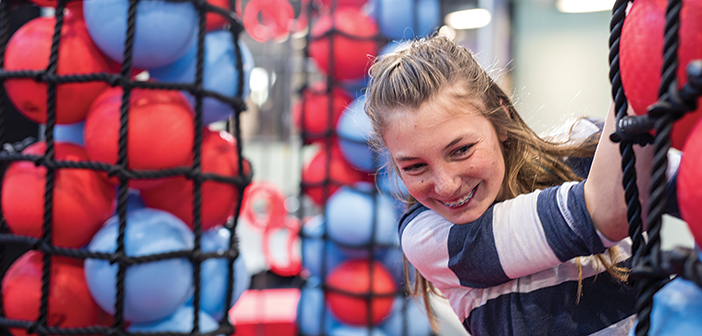
All smiles at the Smugglers’ Notch Fun Zone’s net climb.
Hung on an aluminum or steel truss system constructed by companies such as Custom Design Crafts and Adventure Solutions, obstacles can easily be modified for difficulty or swapped out to keep the course interesting for repeat guests. “We have 10 to 15 obstacles, and we change them out so the course is not the same each week,” says Jennifer Halla, owner of Austin Ninjas (Texas), a 6,000-square-foot, $200,000 ninja course designed for kids.
Powdr Corp, which operates several ski areas as well as its Woodward action sports and lifestyle facilities, has already built six Woodward Wrecktangle ninja courses, with at least four more on the way. It takes a different approach than Austin Ninjas, using an identical design on each Wrecktangle so that participants at all locations can track and compare their times, including via a mobile app.
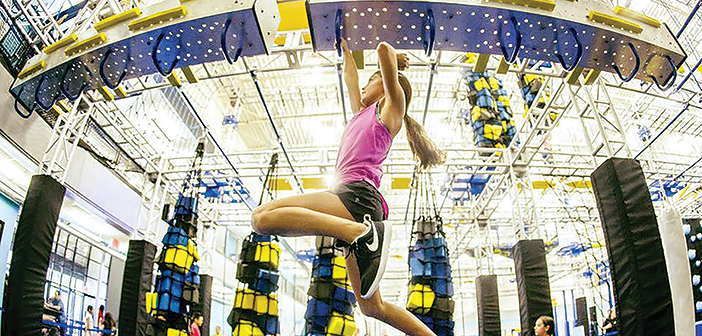
ZavaZone aims for a healthy, active experience for the whole family.
The course can be challenging. “There are definitely obstacles that certain kids can’t do,” says Jeff Suffolk, senior VP of experiential design for Powdr. But it’s designed as a “no fail” race, where falling off an obstacle results in a time penalty, but guests can go on to finish the course.
“I’ve been doing obstacle courses my whole career, and ropes courses have come to the fore and are lots of fun, but ninja courses will be a totally different experience,” says Suffolk, who estimates that more than 100,000 people have tried the Wrecktangles to date.
Taylor Prather, public relations manager at Powdr-owned Copper Mountain, Colo., called the Wrecktangle “a key differentiator for our resort” in a market where other resorts have invested in attractions like zip lines and aerial adventure parks.

Reaching new heights at Smugglers’ Notch.
The Wrecktangle is on a single level, but the 50- x 120-foot structure is “larger than life,” says Suffolk. “It’s designed that if a kid of any age walks past it, there’s no chance they wouldn’t want to try it,” he says.
Adventure Solutions, which got its start constructing zip line, climbing, aerial, and parkour courses, has been building about 60 to 70 ninja courses annually over the last three-plus years. Its clients include Maryland-based ZavaZone (two locations with another two franchises on the way), Ninja Nation (with one location now, but ambitious plans to build 150 parks over the next five years), and the Smuggs’ Warrior Course at Smugglers’ Notch Resort in Vermont.
Adventure Solutions builds customized ninja courses designed for children, teens and adults, and competitive athletes. Course sizes range from less than 2,000 square feet to monster facilities that can sprawl up to 40,000 square feet. Courses can be ground level, multilevel, or elevated.
“Elevated are more expensive, but also have more ‘wow’ factor,” says Scott Hornick, CEO of Adventure Solutions.
Prepare for Warrior Families
The demographic appeal of ninja courses is broad: the TV show features male and female contestants, and while many operators see kids and teens as the target market, adult participation is quite high.
Sarah Schoback, an American Ninja Warrior competitor, founded her Edina, Minn., Obstacle Academy with women and mothers firmly in mind. The $300,000, 4,000-square-foot ninja course includes familiar elements such as quintuplet steps, monkey bars, a pegboard, balance beams, and warped walls that do not discriminate on the basis of age or gender.

Finding the inner ninja on an Adventure Solutions course.
Schoback says men, women, and children can all enjoy these courses, adding that women tend to be more flexible than men, and take more time to analyze the course than their male counterparts. “The appeal for moms and women is that these parks allow kids to have a lot of fun, but they also let you as an adult have fun and get a good workout.”
Halla says that families bring in children as young as five years old, with most kid guests falling into the 7- to 10-year-old range. “The same obstacles that are popular with adults are popular with kids,” says Halla. “Adults struggle with obstacles that kids are able to do. It’s amazing how quickly kids can make improvements.” >>
Even when mom and dad (or grandma and grandpa) aren’t up to attempting the obstacles themselves, the compact setup of a typical ninja course makes it ideal for audience participation. ZavaZone, which has a four-lane ninja course with a total of 16 obstacles in its indoor adventure facilities, admits spectators at no charge. “We want to be a healthy, active experience for the whole family,” says ZavaZone co-founder Joe Henry.
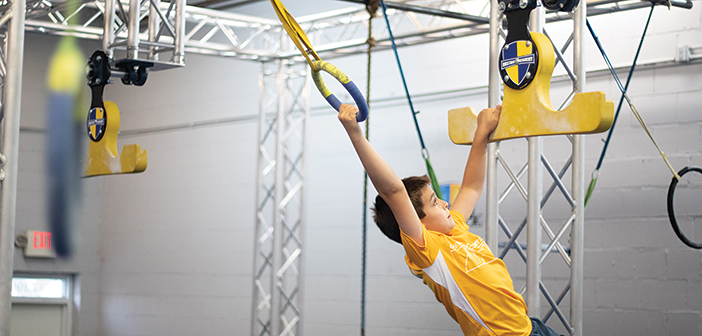
The Wingnut feature at the Obstacle Academy.
At Austin Ninjas and other parks, there are operating hours devoted to “open gym” time, when guests can practice on individual obstacles rather than racing through the course. Parallel courses can be set up to facilitate greater guest movement through the attraction and permit side-by-side racing.
Smugglers’ Notch features a pair of eight-obstacle courses, with one set up to be more difficult than the other—it’s the perfect fit for older and younger sibling rivals. The course is designed to be completed quickly: the record is 30 seconds; most guests take under 5 minutes to finish. “Our goal is ‘attainable,’” says Smuggs’ PR director Mike Chait.
Other courses are more challenging: Hornick estimates that only two percent of guests can complete the salmon ladder obstacle featured on the TV show, for example.
Hornick says each obstacle should be limited to a single participant at a time for safety reasons, but noted that the throughput speed for ninja courses is higher than for ropes courses because guests don’t need to be repeatedly clipped in and out of safety harnesses. “Unlike a ropes course, people are trying to race through it,” he adds.
Outdoor vs. Indoor Ninjas
One of the first questions parks have to answer when considering a ninja course is whether to locate it indoors or outdoors. All of the Wrecktangle courses are outdoors, and Prather says weather has been a challenge at times in a high-altitude environment where lightning storms and guests clambering on a giant metal structure are a bad mix.
Smugglers’ Notch built a new structure to house its Fun Zone 2.0, an expanded attraction opened in April 2017 that includes a warrior course, climbing wall, and platform jump as well as laser tag, an arcade, and slot-car racing. While Smuggs’ has an outdoor ropes course, zip line canopy tour, and a treetop obstacle course, the “wild weather shifts” the resort has been experiencing in recent years made placing the ninja course indoors an easy call, says Chait.
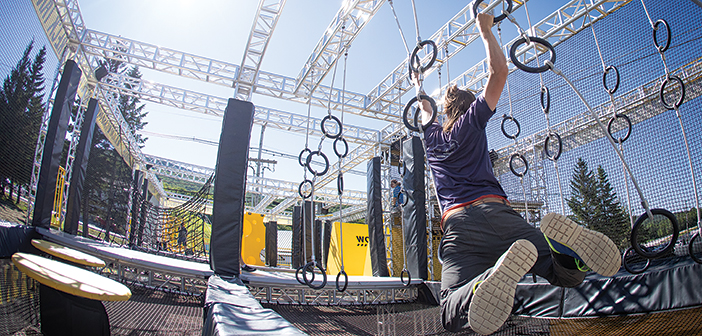
Ring swing at Killington’s Wrecktangle.
“It came up in conversation and it was unanimous that this was the way to go for us,” he says. “It’s easier for us to control our own climate.”
A tall building is a baseline requirement for an indoor ninja course. “We have an 18-foot warped wall, so a pretty good yardstick is to stand on top of that,” says Halla of Austin Ninjas. ZavaZone’s two-level, 9,000-square-foot, $1 million ninja courses are housed in buildings with 26-foot ceilings.
Constructing a ninja course isn’t an inexpensive proposition: construction costs on the courses we looked at ranged from about $100,000 to more than $1 million. Some are designed as standalone attractions, while others are incorporated into resort-style adventure parks or play areas.

Child’s play at ZavaZone.
Rates vary accordingly: the warrior course at Smuggs’ is part of an attraction that’s included as part of a resort stay, with a modest add-on cost of $4 per race. Chait notes that local residents—an important source of repeat business—can buy a two-hour pass with unlimited racing for $15. Austin Ninjas charges a flat fee for two hours of access; at ZavaZone, the admission fee is $19 per hour, $32 for two hours, and $10 for each additional hour after that. A $29 Woodward Wrecktangle ticket gives guests two runs—one “session” to practice, and a timed “race” run.
Playing It Safe
Ninja courses pair nicely with ropes courses, climbing walls, and other activities that represent physical and mental challenges. “A ninja course is similar to a ropes course, but with no safety harness system,” says Hornick. “So you can do things in a ninja course that you can’t do on a ropes course, including more dynamic movements, because guests are not tethered.”
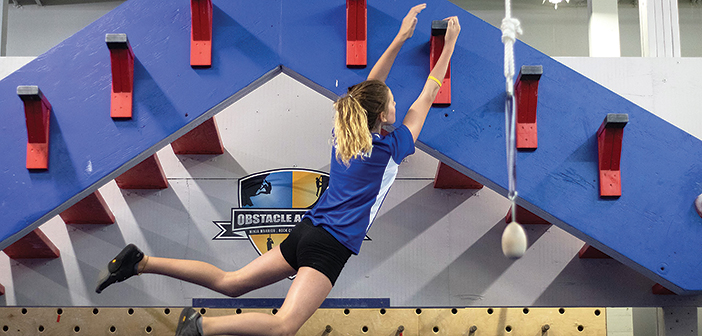
Floating ledges at the Obstacle Academy.
The downside, he says, is “you do need to have very good landing areas, because people are falling off the equipment.” He advises clients against installing the salmon ladder obstacle unless the facility is designed to train athletes, for example. “Even with really good crash netting, you can take some bad falls on it,” he says.
The warped wall is so popular that it’s standard at nearly every ninja park, yet this obstacle is notorious for twisted ankles caused when guests take a running jump for the top of the wall and miss—something to keep in mind when designing a must-have injury waiver form for this attraction.
Depending on the height of obstacles and whether the course is indoors or outdoors, landing areas can be cushioned by crash pads, airbags, foam pits, rubberized surfaces, or trapeze nets (the latter is used on Woodward Wrecktangle courses). Spectacular splashdowns are part of the fun in American Ninja Warrior, but this is another case where what looks great on TV isn’t practical in real life.

Killington’s mountainside Wrecktangle.
“The problem with water is you can only have one person go at a time, and you need lifeguards and a filtration system, so it’s not the best solution in terms of feasibility and management,” says Hornick.
Good personnel policies are also critical for operating a safe ninja course: for example, Woodward employs only coaches trained in sports such as gymnastics and parkour. In terms of numbers, Hornick says parks should staff ninja courses in much the same way ropes courses are staffed.
Powdr’s Suffolk sees a bright future ahead for ninja courses. “As someone who lived through the obstacle race craze—this is more popular,” he says, predicting that ninja competitions will soon become an Olympic sport. “At the end of the day, this is a giant jungle gym, and those have never gone out of style.”
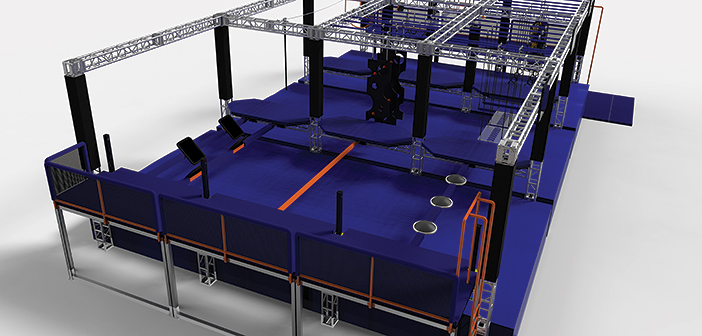
Adventure Solutions’ SkyZone model.






